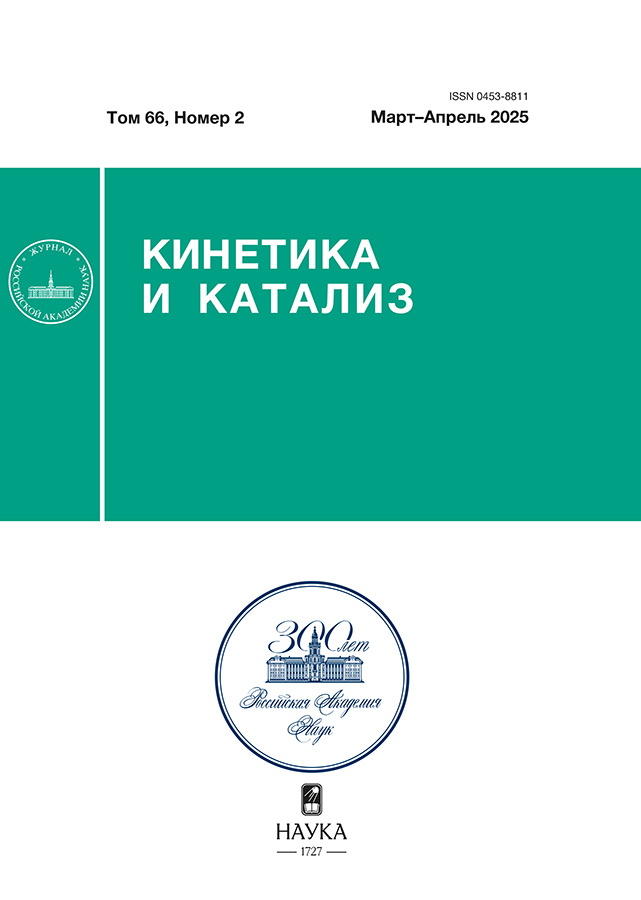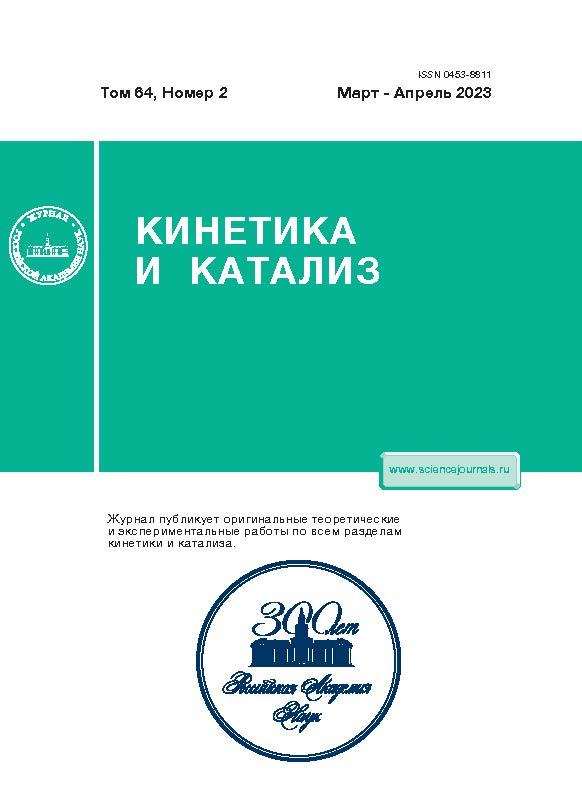Том 64, № 2 (2023)
ОБЗОРЫ
Каталитические методы получения высших 2-кетонов: перспективы Вакер-системы в реакции окисления α-олефинов
Аннотация
Проанализированы и обобщены разработанные за последние 60 лет методы получения неразветвленных 2-кетонов С6−С14 каталитическим окислением линейных α-олефинов. Особое внимание уделено рассмотрению каталитической Вакер-системы, важной для промышленного органического синтеза, и предложенных методов ее модификации. Обсуждены методы управления селективностью реакции, рассмотрена роль сокатализаторов, окислителей и лигандов.
 121-138
121-138


Машинное обучение и анализ больших данных в области катализа
Аннотация
Быстрое развитие экспериментальных методов в каталитических исследованиях в последнее время позволяет получать большие объемы данных. Использование новых статистических и расчетных методов обработки, включающих в себя извлечение информации из экспериментальных данных и их непредвзятую интерпретацию, важно для ускорения развития и внедрения каталитических технологий. Извлечение информации может быть достигнуто с применением статистических подходов: PCA, MCR, ALS. В то же время алгоритмы машинного обучения начинают активно использоваться для интерпретации и построения описательных моделей. В настоящей статье рассматриваются основные методы машинного обучения и примеры их успешного применения для анализа данных инфракрасной и рентгеновской абсорбционной спектроскопии.
 139-152
139-152


СТАТЬИ
Влияние добавок СО2 на некаталитическую конверсию природного газа в синтез-газ и водород
Аннотация
Проведен кинетический анализ некаталитического углекислотного риформинга СН4 в диапазоне температур 1500–1800 К в условиях непостоянной температуры за фронтом отраженной ударной волны. Установлены стадии превращения метана в синтез-газ, соответствующие этим стадиям характерные интервалы времени и наиболее важные элементарные реакции. На первой стадии молекулы метана в результате термического пиролиза последовательно превращаются в этан, этилен, а затем самый стабильный в данном интервале температур ацетилен. На второй стадии ацетилен превращается в СО и Н2, а для богатых смесей – и в частицы сажи. Конверсия СО2 протекает на второй и третьей стадиях, когда практически завершается конверсия СН4. Она происходит в результате взаимодействия молекул СО2 с появившимися в реагирующей системе атомами Н● и приводит к образованию молекул СО и радикалов ОН●. Ацетилен расходуется преимущественно в реакции с радикалами ОН●. Высокая концентрация ацетилена при риформинге метана способствует интенсивному формированию зародышей сажи, для которых ацетилен дает максимальный вклад в скорость их поверхностного роста. При этом сам ацетилен не является предшественником зародышей частиц сажи, которые преимущественно возникают из радикалов \({{{\text{{С}}}}_{{\text{3}}}}{\text{{Н}}}_{3}^{\centerdot }\).
 153-172
153-172


Кинетические закономерности окисления тетрагидрофурана, инициированного 2,2'-азо-бис-изобутиронитрилом
Аннотация
В интервале температур 303–323 K изучены кинетические закономерности окисления тетрагидрофурана, инициированного 2,2'-азо-бис-изобутиронитрилом. За скоростью процесса следили по поглощению кислорода. Показано, что скорость окисления тетрагидрофурана линейно зависит от его концентрации и пропорциональна корню квадратному из концентрации инициатора. Найдены параметр окисляемости тетрагидрофурана и константа скорости инициирования окисления тетрагидрофурана 2,2'-азо-бис-изобутиронитрилом: lg(k2(2k6)–0.5) = 4.3 – 44.1/θ [л0.5 моль–0.5 с–0.5], lg ki = = 13.9 − 120.4/θ [с–1], (где θ = 2.303 × 10–3RT Дж/моль). Константа скорости (k7) реакции пероксильного радикала тетрагидрофурана с α-токоферолом при температуре 303 К составляет (4.0 ± 1.1) × 105 л моль–1 с–1.
 173-180
173-180


Кинетические особенности элонгации нуклеиновых кислот как многостадийной последовательной ферментативной реакции
Аннотация
Изучена кинетика элонгации нуклеиновых кислот как многостадийной последовательной реакции, замыкающейся в цикл. Приведено математически строгое доказательство эмпирических формул, используемых для оценки времени элонгации в зависимости от длины нуклеотидной цепи. Предложены оценки характерного времени элонгации для типичных длин цепи, в т.ч. для нового коронавируса (SARS-CoV-2). Исследована устойчивость кинетики элонгации и выявлено появление при типичных длинах цепи наряду с основной экспоненциальной компонентой решения неустойчивых осциллирующих компонент с растущей амплитудой.
 181-188
181-188


Исследование кинетических особенностей реакций гидродесульфуризации, гидродеазотирования и гидрирования соединений тяжелого нефтяного сырья на сульфидных Ni6PMonW(12 – n)/Al2O3 катализаторах гидроочистки
Аннотация
Проведены кинетические исследования реакций гидродесульфуризации (ГДС), гидродеазотирования (ГДА), а также сравнение гидрирующей активности синтезированных образцов Ni6PMonW(12 – n)/Al2O3 и импортного катализатора гидроочистки вакуумного газойля в процессе гидрооблагораживания тяжелого смесевого нефтяного сырья. Показано, что реакция ГДС описывается уравнением псевдовторого порядка, а реакция ГДА – псевдопервого. Полученные гидрогенизаты отвечают требованиям, предъявляемым к качеству сырья установок каталитического крекинга по коксуемости, содержанию серы и азота.
 189-202
189-202


Разложение аммиака на кобальт-силикагелевых катализаторах синтеза Фишера–Тропша
Аннотация
Показана возможность применения кобальт-силикагелевых катализаторов синтеза Фишера–Тропша для разложения аммиака в проточном режиме в трубчатом реакторе со стационарным слоем катализатора при давлении 0.1 МПа, объемной скорости газа 1000–6000 ч–1 в интервале температур 400–650°С. Активность и производительность по водороду уменьшаются в ряду Co–Ru/SiO2 ≥ ≥ Co–Al2O3/SiO2 > Ru/SiO2 > Co–Al2O3/SiO2(35%)/ZSM-5(30%)/Al2O3(35%). Относительно небольшие эффективные энергии активации, оцененные для всех катализаторов, позволяют проводить реакцию с приемлемой конверсией при умеренных температурах.
 203-215
203-215


Влияние гидридной и карбидной фаз наночастиц палладия на частоты колебаний адсорбированных на их поверхности молекул
Аннотация
Материалы на основе палладия, в том числе наночастицы, находят широкое применение в нефтехимической, фармацевтической, автомобильной и других областях промышленности. Образующиеся в процессе реакций гидрирования или окисления углеводородов гидридные, карбидные и оксидные фазы палладия ощутимо влияют на каталитические свойства палладиевого катализатора. На основе теоретических расчетов, проведенных методом теории функционала плотности (ТФП), показано влияние межатомарных расстояний Pd–Pd и присутствия атомов углерода, занимающих октаэдрические пустоты в ГЦК-решетке палладия, на колебательные частоты адсорбированных углеводородов, представленных этилиденом. Теоретические изыскания подкрепляются экспериментальными данными инфракрасной (ИК) спектроскопии диффузного отражения (DRIFTS), снятыми в режиме in situ в процессе образования карбидной и гидридной фаз палладия в коммерческих нанокатализаторах Pd/Al2O3 под воздействием этилена и водорода. Предлагаемый подход может быть использован для развития методов анализа ИК-спектров с целью количественной диагностики структурных изменений палладия в процессе различных каталитических реакций в режиме in situ.
 216-226
216-226


Получение композитных углерод-силикатных материалов, их исследования и испытания для приготовления гетерогенных биокатализаторов низкотемпературного синтеза сложных эфиров
Аннотация
Композитные углерод-силикатные материалы (КУСМ), различающиеся содержанием углеродного и силикатного компонентов, были получены с участием двух предшественников диоксида кремния (силиказоля и силана) и многостенных углеродных нанострубок (МУНТ). На начальной стадии получения КУСМ методом 1 использовали пропитку по влагоемкости тонкодисперсного порошка МУНТ силиказолем, методом 2 – обработку МУНТ тетраэтоксисиланом с последующим гидролизом и поликонденсацией. Содержание диоксида кремния (SiО2) в композитах варьировали от 3 до 60 мас. %. После сушки и соответствующей термообработки при 250–350°С композитные материалы были исследованы различными физико-химическими методами: азотная порометрия, электронная микроскопия, рентгено-флуоресцентный анализ, термогравиметрический анализ. Были обнаружены существенные различия параметров в зависимости от химического состава КУСМ, в том числе текстурных характеристик. Так, при увеличении содержания SiО2 удельная поверхность композитных материалов увеличивалась (в 2 раза), на кривых распределения по диаметрам пор наблюдались максимумы (при 20–40 нм). Композитные материалы исследовали в качестве носителей-адсорбентов для приготовления гетерогенных биокатализаторов (БК) низкотемпературного синтеза сложных эфиров, активным компонентом в которых была липаза, иммобилизованная исключительно на углеродной поверхности нанотрубок. При уменьшении содержания МУНТ в полученных композитных материалах ферментативная активность и операционная стабильность БК, измеренные в реакции этерификации гептановой кислоты (С7) бутанолом (С4), монотонно уменьшались, достигая 2–8-кратного падения активности при максимальном содержании SiО2 (58 мас. %).
 227-242
227-242


Исследование регенерации катализатора Rh/Ce0.75Zr0.25O2 – δ/θ-Al2O3/FeCrAl после автотермического риформинга дизельного топлива
Аннотация
Проведено исследование сажеобразования на поверхности структурированного катализатора Rh/Ce0.75Zr0.25O2/Al2O3/FeCrAl в ходе автотермического риформинга дизельного топлива в синтез-газ. Методом СЭМ на поверхности катализатора обнаружено формирование частиц волокнистого углерода размером 5–50 мкм. Установлено, что процесс зауглероживания происходит на поверхности каталитического покрытия и не вызывает его отслоения и повреждения, а расположение углеродных отложений не препятствует их окислению во время регенерации с использованием кислорода воздуха или водяного пара. Показано, что реакция окисления сажи кислородом начинает активно протекать при температуре 450°С, большая часть углерода окисляется еще до выхода печи реактора на рабочую температуру автотермического риформинга дизельного топлива (750°С). Водяной пар также способен окислять образующиеся углеродные отложения, но с меньшей эффективностью, чем кислород. Процесс регенерации паром активно протекает при температуре 750°С, что указывает на возможность саморегенерации катализатора в автотермическом риформинге дизельного топлива, где вода подается в избытке.
 243-248
243-248












